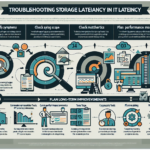Troubleshooting IT infrastructure integration issues can be complex due to the diverse components involved, such as servers, storage systems, virtualization platforms, networks, and applications. Below is a structured approach to help you address integration challenges effectively:
1. Identify the Scope and Impact
- Understand the problem: Gather detailed information about the issue from users, logs, or monitoring tools.
- Is the problem affecting a specific component (e.g., storage, server, network) or the integration between systems?
- Is it intermittent or persistent?
- Assess the impact: Determine the severity and the business-criticality of the issue.
- Is it impacting production, backups, or test environments?
2. Gather Information
- Logs and Monitoring Tools:
- Analyze system logs (e.g., application logs, OS logs, network device logs).
- Use monitoring tools (e.g., Prometheus, Nagios, Zabbix, SolarWinds) to identify anomalies.
- Configuration Details:
- Review configuration files for servers, storage, virtualization, and Kubernetes clusters.
- Verify compatibility between software versions, drivers, and firmware.
- Documentation:
- Check vendor documentation for known issues.
- Review change management records to identify recent updates, patches, or hardware installations.
3. Check the Basics
- Connectivity and Networking:
- Verify physical connections (cables, switches, power).
- Use basic tools like
ping,traceroute, ornslookupto check network connectivity. - Ensure VLANs, subnets, and firewall rules are correctly configured.
- Resource Availability:
- Check CPU, memory, disk, and network utilization on servers and storage systems.
- Look for bottlenecks or resource contention.
- DNS and Authentication:
- Confirm DNS resolution and authentication mechanisms (Active Directory, LDAP, Kerberos) are functioning properly.
4. Isolate the Problem
- Divide and Conquer:
- Break down the infrastructure into smaller components (e.g., server, storage, virtualization, Kubernetes pods).
- Test each component independently to locate the issue.
- Recreate the Issue:
- Attempt to replicate the problem in a test environment or sandbox.
- Compare the behavior in production vs. testing.
5. Common Areas of Investigation
- Servers:
- Check hardware health (RAID, memory, CPU, GPU status).
- Verify firmware or driver compatibility.
- Validate hypervisor configurations if using virtualization platforms like VMware or Hyper-V.
- Storage:
- Ensure proper connectivity to storage systems (SAN, NAS, or DAS).
- Check for storage performance issues or misconfigured LUNs/volumes.
- Virtualization:
- Validate VM resource allocations (CPU, RAM, storage).
- Review hypervisor logs for errors (e.g., VMware vSphere, Hyper-V).
- Kubernetes:
- Troubleshoot pod failures using
kubectl logsandkubectl describe. - Check cluster health using
kubectl get nodesandkubectl get pods. - Investigate network policies and ingress/egress rules.
- Backup Systems:
- Review backup schedules and job logs.
- Ensure that backup systems can access storage targets (e.g., tapes, disk arrays).
6. Use Tools for Diagnosis
- Network Tools:
Wiresharkortcpdumpfor packet analysis.iperffor network throughput testing.- Storage Tools:
- Vendor-specific tools (e.g., NetApp OnCommand, Dell EMC Unisphere).
- Server Monitoring:
- Tools like
top,htop,vmstat, ordstatfor Linux. - Windows Event Viewer and Performance Monitor for Windows.
- Virtualization Tools:
- VMware vSphere Client, Hyper-V Manager, or OpenStack Horizon.
- Kubernetes Debugging:
- Use tools like
kubectl,k9s, or Prometheus/Grafana for cluster monitoring.
7. Rollback or Apply Fixes
- Rollback Changes:
- If the issue started after a recent change (e.g., patch, update, new integration), consider rolling back to the previous stable state.
- Apply Fixes:
- Update configurations, reinstall problematic components, or apply vendor-recommended patches.
- Automate fixes where possible using scripts or configuration management tools (e.g., Ansible, Puppet, Chef).
8. Document Findings
- Root Cause Analysis:
- Identify the exact cause of the issue and document it for future reference.
- Lessons Learned:
- Share findings and preventive measures with your team.
- Update Documentation:
- Revise runbooks, operational manuals, and integration workflows.
9. Prevent Future Issues
- Proactive Monitoring:
- Set up alerts to detect anomalies early.
- Regular Maintenance:
- Perform periodic updates, audits, and health checks of the IT infrastructure.
- Training:
- Train your team on troubleshooting and monitoring best practices.
- Redundancy and Failover:
- Implement high-availability configurations to minimize downtime during failures.
By following this structured approach, you can systematically identify and resolve IT infrastructure integration issues while minimizing disruption to your environment.
How do I troubleshoot IT infrastructure integration issues?





